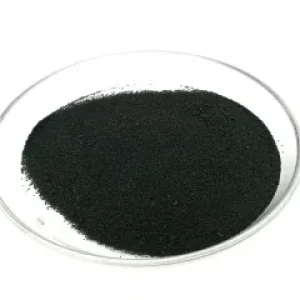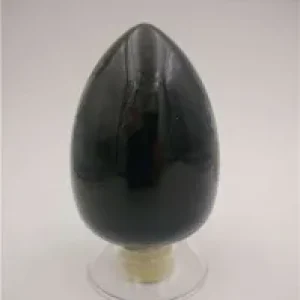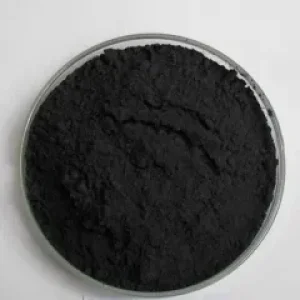Overview of Iron Carbide Fe3C Powder
Iron carbide is an inorganic substance. Iron carbide’s chemical formula is Fe3C. It is a compound of iron and carbon, specifically an intermediate transition metal carbide with transition formula Fe3C. By weight, it is 6.67% carbon and 93.3% iron. It is called cementite in metallurgy. Iron carbide is an off-white crystalline powder with a relative density 7.694 and a melting point of 1250°C. Insoluble in water, soluble in acid. Iron carbide is an orthorhombic crystal. Each carbon atom is surrounded by six iron atoms at the top corners, forming an octahedral structure. Two octahedrons share each iron atom. That is, the carbon atoms are coordinated. The number is 6, and the coordination number of the iron atom is 2. Iron carbide is an interstitial compound formed at high temperatures. Carbon and iron have a strong bonding force, and the performance is hard and brittle.
Iron carbide is a hard, fragile material, usually classified as ceramic in its pure form, and is an important component often found in ferrous metallurgy. Although cementite is present in most steel and cast iron, it is produced as a raw material for the iron carbide process. It belongs to the family of alternative ironmaking technologies. Theoretically, the name cementite structure of solidified steel consists of a kind of cell tissue, with ferrite as the nucleus and Fe3C as the cell envelope.
Properties of Iron Carbide Fe3C Powder
Iron carbide Fe3C. It is called metal cementite in metallurgy. It is a gray-black crystalline powder with a relative density of 7.694 and a melting point of 1837 °C. Do not dissolve in water, soluble in acid. In orthogonal crystals, each carbon atom is surrounded by six iron atoms at the apex angle, forming an octahedral structure. Two octahedrons share each iron atom. That is, the coordination number of carbon atoms is 6, iron. The atomic coordination number is 2. The iron to carbon atoms ratio in the chemical formula is Fe: C = 1/2 × 6: 1 = 3:1.
Production Method of Iron Carbide Fe3C Powder
Carbothermal reduction method
Carbon thermal reduction is a commonly used method for preparing iron carbide, which is to react coke or graphite with iron oxide in an oxygen-free or weakly oxidizing atmosphere under high-temperature conditions. The reaction equation of this method is:
Fe2O3(s)+ 3C(s) → 2Fe3C(s)
The reaction must be carried out at high temperatures, so it must be heated using a high-temperature furnace. At the same time, the atmosphere in the reaction will affect the formation of iron carbide; if there is a lot of oxygen, it will generate iron trioxide. Therefore, to prepare iron carbide with higher purity, it is necessary to strictly control the reaction conditions.
Electrothermal method
An electrothermal method uses electric energy to produce high 0temperature so that an iron oxide reduction reaction produces iron carbide. In the electrothermal method, graphite is usually used as the electrode so that the iron oxide on the surface of the graphite electrode electrochemical reduction reaction produces iron carbide. The reaction equation of this method is:
Fe2O3(s) + 3/2C(s) + 3/2O2(g) → 2Fe3C(s) + 3/2CO2(g)
The advantage of the electrothermal method is that it can directly use electrical energy to produce high temperatures, so the temperature and reaction time can be easily controlled. At the same time, because the reaction is carried out on the electrode surface, high-purity iron carbide can be obtained. However, the cost is higher due to the need to use a lot of electricity.
Vapor deposition method
Vapor deposition is a method of depositing iron carbide on the surface of a matrix by chemical reaction or physical deposition. This method usually uses gases such as methane, hydrogen, and nitrogen as raw materials to chemically react with iron oxide under high temperatures and pressure to generate iron carbide and deposit it on the surface of the matrix. The reaction equation of this method is:
Fe2O3(s)+ 3CH4(g) → 2Fe3C(s)+ 9H2O(g)
The benefit of the vapor deposition method is that the iron carbide layer can be directly deposited on the surface of the substrate, so high purity and high-density iron carbide coating can be obtained. At the same time, the cost is low because there is no need to use a lot of electricity. However, the equipment investment is large due to the need to use high-temperature and high-pressure equipment.
Plasma method
The plasma method is a material preparation method using the high temperature and high-speed characteristics of plasma. In the plasma method, gases such as hydrogen, nitrogen, and methane are usually used as raw materials to ionize and accelerate the bombardment to the substrate surface through the high temperature and high-speed characteristics of the plasma so that the reduction reaction of iron oxide generates iron carbide. The reaction equation of this method is:
Fe2O3(s)+ 3/2CH4(g) → 2Fe3C(s)+ 3H2O(g)
The advantage of the plasma method is that the iron carbide coating can be directly formed on the substrate surface, so high purity and high-density iron carbide coating can be obtained. At the same time, because the temperature and speed of the plasma are adjustable, the coating’s reaction conditions and thickness can be easily controlled. However, the equipment investment is large due to the need to use large plasma generators, high-precision control systems, and other equipment.
Technical Parameter of Iron Carbide Fe3C Powder
|
||||||||||||||||||||||
Application of Iron Carbide Fe3C Powder
Wear-resistant material
Iron carbide has high hardness and wear resistance and can be widely used as a wear-resistant material in various mechanical parts and tools. For example, the use of iron carbide on the bucket of an excavator can improve its wear resistance and service life. In addition, iron carbide can also be used to manufacture precision tools such as cutting tools, drills, and measuring tools to improve their hardness and wear resistance.
Cemented carbide
Iron carbide is an important part of cemented carbide that can be mixed with cobalt, chromium, and other metals to make a variety of cemented carbides with high hardness, high strength, high wear resistance, and other advantages. Iron carbide carbide is widely used in manufacturing to process high-temperature alloys, stainless steel, and other difficult materials to improve its processing efficiency and product quality.
Powder smelting
Powder smelting is a method of melting and solidification by heating metal powder or metal oxide powder above the melting point. In powder smelting, iron carbide can be added as an additive to metal powder to improve its hardness and wear resistance. For example, a certain amount of iron carbide can be added to improve its wear resistance and hardness in the manufacture of high-speed steel.
Electronics industry
Iron carbide can be used in the electronics industry to manufacture precision electronic components such as integrated circuit chips and magnetic memory devices. Because of its high hardness, high density, and high wear resistance, iron carbide can be used as an electrode and conductive material in electronic devices to improve its performance and stability.
Other applications
Iron carbide can also be used in other fields. For example, iron carbide can be used as a catalyst in chemical reactions, as a structural material in construction and automobile manufacturing, and as a protective coating for metal surface treatment. In short, iron carbide has a wide range of application prospects because of its unique physical and chemical properties.
Storage Condition of Iron Carbide Fe3C Powder
Iron Carbide Fe3C Powder should be sealed in a vacuum and stored in a cool and dry room and it should not be exposure to air. In addition, the product should be avoided under stress.
Company Profile
My Carbides is a trusted global chemical material supplier & manufacturer with over 12-year-experience in providing super high-quality carbides and relatives products.
The company has a professional technical department and Quality Supervision Department, a well-equipped laboratory, and equipped with advanced testing equipment and after-sales customer service center.If you are looking for high-quality Carbides, please feel free to contact us or click on the needed products to send an inquiry.
Payment Methods of Iron Carbide Fe3C Powder
L/C, T/T, Western Union, Paypal, Credit Card etc.
Shipment of Iron Carbide Fe3C Powder
It could be shipped by sea, by air, or by reveal ASAP as soon as repayment receipt.
Package of Iron Carbide Fe3C Powder
Vacuum packing, 100g, 500g or 1kg/bag, 25kg/barrel, or as your request.
FAQ
Q1: Is iron carbide stable?
Answer: Iron carbide is stable at room temperature, but at high temperatures or under certain conditions, it may react with other substances. Therefore, high temperatures and humid environments need to be avoided when storing and using iron carbide.
Q2: Is iron carbide harmful to the human body?
Answer: Iron carbide itself is not directly toxic, but inhaling its dust for a long time may cause irritation or damage to the lungs. Therefore, when working with iron carbide, appropriate protective equipment should be worn and the workplace should be well ventilated.
Q3: What are the differences in properties between iron carbide and silicon carbide?
Answer: There are significant differences in properties between iron carbide and silicon carbide. Silicon carbide has a higher hardness and melting point, while iron carbide has different chemical activities and applications.
Q4: Is iron carbide used in the field of environmental protection?
Answer: Although iron carbide has few direct applications in the field of environmental protection, it indirectly affects environmental protection and energy efficiency due to its important role in metallurgy and energy conversion.
Q5: What are the applications of iron carbide in the ceramic industry?
Answer: In the ceramic industry, iron carbide can be used as an additive to improve the physical and chemical properties of ceramic materials, such as hardness, wear resistance and high temperature resistance.









